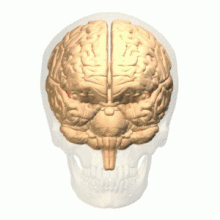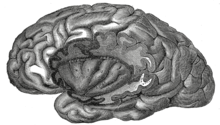Island bark
The insular cortex , also called insular cortex , cortex insularis , lobus insularis , insula , island or Reilsche island (after Johann Christian Reil , who first described it in 1796), is part of the cerebral cortex . Each half of the cerebrum ( telencephalon ) has an island; it is covered by the opercula of the frontal , parietal and temporal lobes .
In the prenatal development of man the growth in size of the island is low, so that their cattle shares than other lobes of the cerebrum than frontal operculum , operculum frontoparietal and Operculum temporal the insula cover. As a result of this opercularization (capping) it lies in the depth of the lateral sulcus , in the lateral cerebral fossa . The island is separated from the opercula by the circular sulcus . From the island pole, five to nine turns radiate out in a fan shape, the sulcus centralis insulae divides them into a front area with the gyri breves insulae and a rear area with the gyrus longus insulae . With its limen insulae (island threshold ), it borders on the paleocortical substantia perforata rostralis. The insular cortex itself is part of the neocortex .
Ontogenetically , the island represents that part of the cerebral hemisphere that is connected to the hemisphere stem. Starting from this area, during the development of one cerebral hemisphere, its expansion and thus its superficial division into four different lobes takes place: in the frontal direction ( frontal lobe ), in the parietal ( parietal brain ), in the occipital ( occipital brain ) and in the temporal ( temporal lobe ). Some slam the island into the temporal brain, others see it as a separate structure.
The functional services of the insular bark are not fully understood. Together with cortical areas of the temporal lobe pole and the orbital and medial areas of the frontal lobe, it is part of the paralimbic cortex , which is closely connected to various parts of the limbic system . The insular cortex has a special position here, as it has reciprocal connections to cingulate cortex areas and the amygdala as well as to primary and associative areas of the cerebral cortex. While the rear island area mainly processes somaesthetic , also nociceptive , kinesthetic and acoustic information, in the front area it is mainly olfactory , gustatory and visceral information .
The emotional evaluation of pain is associated with areas of the posterior islet. In addition, there are indications that the rear parts of the insula are important for perceptions of the sense of balance . It is also assumed that parts of the insular bark function as associative areas for auditory (especially language-mediated) thinking.
The insular cortex of the gyri breves , on the other hand, plays a role in the (conscious) perception of chemoreceptive signals for the sense of taste (→ gustatory cortex ), probably also in the case of smells . Frontal parts of the island should also be involved in empathic skills. Recent research indicates a connection in the distinction between love vs. Sensations of pleasure, each of which leads to slightly different activation patterns of the insular bark.
Damage to the insula caused by a stroke can prevent even heavy smokers from craving nicotine. Scientists at the University of Iowa even believe that these findings could lead to the development of drugs to combat nicotine addiction.
swell
- ↑ Alfred Benninghoff and Kurt Goerttler : Textbook of Human Anatomy. Shown with preference given to functional relationships. Vol. 3: Nervous system, skin and sensory organs. Urban and Schwarzenberg, Munich 7 1964; Pp. 6-7
- ↑ Benninghoff: Macroscopic and microscopic anatomy of humans, Vol. 3. Nervous system, skin and sensory organs . Urban and Schwarzenberg, Munich 1985, ISBN 3-541-00264-6 , p. 395.
- ↑ WHERE Guldin / O.-J.Grüsser: Is there a vestibular cortex ?, in Trends in Neurosciences 21 (6), p. 254-259 (1998)
- ↑ Th. Brandt, M. Dieterich, A. Danek: Vestibular cortex lesions affect the perception of verticality. In: Annals of Neurology. 35, 1994, pp. 403-412, doi : 10.1002 / ana.410350406 .
- ^ Andreas Olsson, Katherine I. Nearing, and Elizabeth A. Phelps (2007). Learning fears by observing others: the neural systems of social fear transmission . Social Cognitive and Affective Neuroscience, 2, pp. 3-11
- ↑ Bartels, Andreas & Zeki, Semir: The neural correlates of maternal and romantic love, in: NeuroImage Vol. 21 (3), p. 1155 - 1166 (2004) , PDF
- ↑ Stephanie Cacioppo, Francesco Bianchi-Demicheli, Chris Frum, James G. Pfaus, James Lewis (2012) The Common Neural Bases Between Sexual Desire and Love: A Multilevel Kernel Density fMRI Analysis . J Sexual Medicine 9: 1048-1054, doi : 10.1111 / j.1743-6109.2012.02651.x
- ↑ Naqvi, Nasir H. / Rudrauf, David / Damasio, Hanna / Bechara, Antoine: Damage to the Insula Disrupts Addiction to Cigarette Smoking, in: Science Magazine 315 (5811), p. 531-534 (2007) , PDF
literature
- Bamiou: The insula (Island of Reil) and its role in auditory processing

